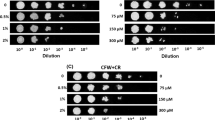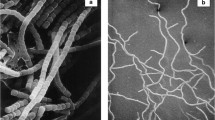Abstract
Results of chemical analysis and ultrastructural study of the cell wall of a thermosensitive dimorphic mutant ofParacoccidioides brasiliensis support the involvement of α-1,3-glucan in the process of dimorphism, but do not support a possible role of this glucan as being responsible for the yeast-like morphology of this pathogenic fungus.
Similar content being viewed by others
Literature Cited
Carbonell, L. M. 1969. Ultrastructure of dimorphic transformation inParacoccidioides brasiliensis. Journal of Bacteriology100:1076–1082.
Carbonell, L. M., Pollak, L. 1963. Ultraestructural delParacoccidioides brasiliensis en cultivos de la fase levaduriforme. Mycopathologia et Mycologia Applicata19:184–204.
Carbonell, L. M., Rodríguez, J. 1965. Transformation of mycelial and yeast forms ofParacoccidioides brasiliensis in culture and in experimental inoculations. Journal of Bacteriology90:504–510.
Carbonell, L. M., Rodríguez, J. 1968. Mycelial phase ofParacoccidioides brasiliensis andBlastomyces dermatitidis: an electron microscope study. Journal of Bacteriology96:533–543.
Furtado, J. S., de Brito, T., Freymuller, E. 1967. The structure and reproduction ofParacoccidioides brasiliensis in human tissue. Sabouraudia5:226–229.
Hallak, J., San-Blas, F., San-Blas, G. 1982. Isolation and wall analysis of dimorphic mutants ofParacoccidioides brasiliensis. Sabouraudia20:51–62.
Kanetsuna, F., Carbonell, L. M., Azuma I., Yamamura, Y. 1972. Biochemical studies on the thermal dimorphism ofParacoccidioides brasiliensis. Journal of Bacteriology110:208–218.
Nickerson, W. J. 1948. Enzymatic control of cell division in microorganisms. Nature (London)162:241–245.
Restrepo, A. 1970. A reappraisal of the microscopical, appearance of the mycelial phase ofParacoccidioides brasiliensis. Sabouraudia8:141–144.
Reynolds, E. S. 1963. Use of lead citrate at high pH as an electron opaque stain in electron microscopy. Journal of Cell Biology17:208–213.
San-Blas, F., San-Blas, G., Inlow, D. 1980. Dimorphism inParacoccidioides brasiliensis, pp. 23–28. In: H. J. Preusser (ed.), Medical Mycology: Proceedings of the Mycological Symposia of the XII International Congress of Microbiology, Munich. Stuttgart: Gustav Fischer Verlag.
San-Blas, G., Carbonell, L. M. 1974. Chemical and ultrastructural studies on cell walls of the yeastlike and mycelial forms ofHistoplasma farciminosum. Journal of Bacteriology119:602–611.
San-Blas, G., San-Blas, F. 1977.Paracoccidioides brasiliensis: cell wall structure and virulence. Mycopathologia62:77–86.
Watson, M. L. 1958. Staining of tissue sections for electron microscopy with heavy metals. Journal of Biophysical and Biochemical Cytology4:475–480.
Author information
Authors and Affiliations
Rights and permissions
About this article
Cite this article
San-Blas, F., San-Blas, G., Hallak, J. et al. Ultrastructure and cell wall chemistry of a thermosensitive mutant ofParacoccidioides brasiliensis . Current Microbiology 8, 85–88 (1983). https://doi.org/10.1007/BF01566963
Issue Date:
DOI: https://doi.org/10.1007/BF01566963




